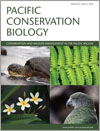
Pacific Conservation Biology
Volume 22 Number 4 2016
PCv22n4_EDReflections on two years of change at Pacific Conservation Biology
PC16003Manta ray tourism management, precautionary strategies for a growing industry: a case study from the Ningaloo Marine Park, Western Australia
Manta ray interaction tourism is reviewed, with a particular focus on Ningaloo Reef, Western Australia. The use of the precautionary principle is advocated to guide the design and implementation of management strategies. An increase in the level of industry management is advised and specific recommendations are provided for management strategies.
PC16007Fauna-rescue programs highlight unresolved scientific, ethical and animal welfare issues
In response to a paper advocating large-scale, multi-species ‘fauna-rescue’ programs when habitat is being destroyed, we urge caution by highlighting the lack of evidence of success in such programs. We argue that any benefits are likely to be outweighed by ecological and animal welfare risks, and that any conservation gains are likely to be illusionary.
PC16015Response to ‘Fauna-rescue programs highlight unresolved scientific, ethical and animal welfare issues’ by Menkhorst et al.
There is limited knowledge on the success or failure of fauna relocations associated with vegetation clearing programs. This paper comments on issues raised by other authors and provides some suggested guidelines that can be applied in the absence of scientific evidence.
PC15039Changes in habitat use and distribution of mouflon in the Kahuku Unit of Hawai‘i Volcanoes National Park
European mouflon sheep (Ovis gmelini musimon) have become invasive in Hawai‘i and other locations. Eradication of mouflon has been difficult because their behaviour is not like that of feral domestic ungulates. Our results suggest that the habitat use and distribution of mouflon also changes in response to extended eradication efforts.
PC15034What environmental, social or economic factors identify high-value wetlands? Data-mining a wetlands database from south-eastern Australia
Large amounts of potentially useful information are collected by management agencies as they attempt to identify high-value wetlands and rank them for investment, protection or rehabilitation. Only rarely are the resultant databases subject to a full quantitative analysis. We show how such potentially useful, and mostly under-utilised, databases can be interrogated with a suite of analytical tools, including artificial intelligence approaches, and how this can lead to more informed, transparent, reproducible and transferable assessments, and to better conservation outcomes.
PC16006An evaluation and comparison of spatial modelling applications for the management of biodiversity: a case study on the fragmented landscapes of south-western Australia
Spatial modelling tools are increasingly used in biodiversity conservation planning but with many approaches it is often difficult to know which to employ. Using a case study in a biodiversity hotspot, we evaluated five commonly used modelling techniques and found that none of the applications used met all our criteria. Consequently, we advocate a hybrid approach of multiple techniques to identify, quantify and ameliorate threats to regional biota.
PC15043Resolving the taxonomy, range and ecology of biogeographically isolated and critically endangered populations of an Australian freshwater galaxiid, Galaxias truttaceus
This study investigated genetic, geographic and ecological criteria of populations of Galaxias truttaceus in Western Australian and found that these populations should be considered as an evolutionary significant unit. Management of these should be a high conservation priority.
PC16014Social landscape of the night parrot in western Queensland, Australia
Attitudes of owners/managers of properties in western Queensland potentially supporting recently rediscovered night parrots were explored to understand whether they would be sympathetic to species conservation through property management. Interviews found a high level of support, especially if disruption was minimal and compensation available, suggesting collaborative management with local graziers can contribute substantially to night parrot conservation.
PC15031Identifying High Value Arboreal Habitat in forested areas using high-resolution digital imagery
We present a new method to identify and map ‘High Value Arboreal Habitat’ at a fine scale using high resolution digital imagery to capture important areas of old forest across the landscape which have high conservation value.
PC15020Marine invasive species: establishing pathways, their presence and potential threats in the Galapagos Marine Reserve
Marine biological invasions have increased significantly in recent years due to global trade, transport and tourism. Invasive non-native species are the number one threat to Galapagos ecosystems and although many preventive and corrective measures have been applied to terrestrial problems, the impacts of invasive non-native species in the marine environment have received relatively little attention until now.
PC16008Exploring the use of a fragmented landscape by a large arboreal marsupial using incidental sighting records from community members
The study explores the use of a fragmented landscape by Lumholtz’s tree-kangaroos (Dendrolagus lumholtzi). The spatial distribution of suitable habitat and the ability of the species to move into various types of matrices suggest that the current degree of fragmentation of the Atherton Tablelands in North Queensland provides functional connectivity for this species.



